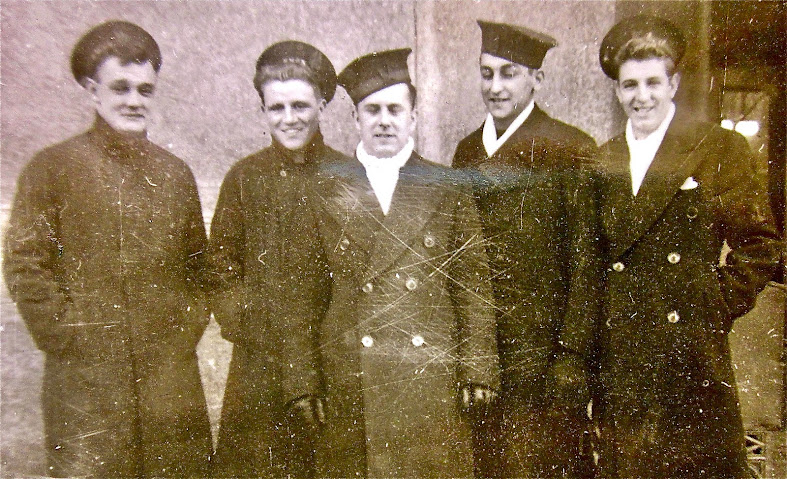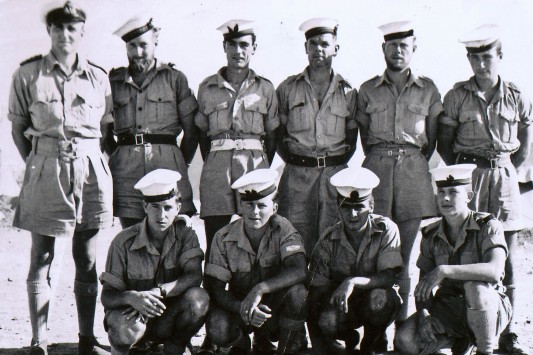The 80th Anniversary of Operations HUSKY and BAYTOWN, 1943
Ten Links Provide Context, News of the Day, Memorable Memoirs...
This is very likely GEORGE or HOW Beach, where Canadians in Combined
Operations transported 'the material of war' for 4 weeks, July - Aug., 1943
Photo from They Left the Back Door Open by Lionel S.B. Shapiro, 1944
In my recent entries I have drawn attention to books, stories, news clippings, maps and more related to the Allied invasions of Sicily and Italy in 1943, 80 years ago this summer. With a trip already planned to visit GEORGE Beach (now modern day Fontane Bianche, a few miles south of Syracusa), where the 80th Flotilla of Canadian Landing Craft - including my father Doug Harrison (Sept. 1920 - Feb. 2003) - transported all materials of war during the month of July and early August, my mind has been on little else.
Below I have listed a few items that will shine the light on three months in the Mediterranean, as experienced by members of RCNVR/Combined Operations aboard landing craft assault, landing craft mechanised and landing craft infantry (large), aka LCAs, LCMs and LCI(L)s.
Liners right inshore, 4 miles south of Syracuse unloading troops
and landing craft. Photo - Roper, F G (Lt) © IWM A 18090
Excerpt from beginning of text re Sicily, page 126:
2. Combined Operations by Clayton Marks (RCNVR/Combined Ops), from London, Ontario. 200-plus pages, Canadian WWII Combined Ops veterans' stories from initial training to Normandy, 1941 - 1945. Can be purchased by contacting GH at gordh7700@gmail.com
Click here to view Short Story re Invasions of Sicily and Italy, July 10, 1943 and September 3, 1943.
Map as found in Combined Operations, page 76
3. Two volumes of stories by Canadian WWII veterans of RCNVR and Combined Operations.
St. Nazaire to Singapore Volume 2 (re Normandy, individual reports and more)
Lengthy stories about Operation HUSKY (Sicily) begin in Volume 1, page 142.
The following excerpt is from the diary of Lt. (Engineer) Keith Beecher, RCNVR, a member of the 55th Flotilla of Landing Craft Assault (LCA):
The following excerpt is from the diary of Lt. (Engineer) Keith Beecher, RCNVR, a member of the 55th Flotilla of Landing Craft Assault (LCA):
Details re another Canadian Flotilla of LCAs (the 61st) can also be
found in St. Nazaire to Singapore, Volume 1, pages 156 - 157
The following excerpt is from the diary of AB (able bodied seaman) Billy Lindsay, RCNVR/Combined Operations, Victoria, B. C., a member of the 81st Flotilla of Landing Craft, Mechanised (LCM):
As found on page 186, St. Nazaire to Singapore, Volume 1
Details about the July 11 sinking of HMHS Talamba is found here
4. The Navy memoirs of LS/Coxs'n Doug Harrison from "Dad, Well Done".
Please click here to read memoirs related to the invasion of Sicily and Italy.
Chapter SEVEN. Italy
Canadians in RCNVR/ Combined Ops ready for Toronto train to Combined
Ops School at HMCS Givenchy III, Vancouver Island. January 1944. GH
L - R: D. Linder (Kitchener), Doug Harrison (Norwich), Joe Watson
(Simcoe), Buryl McIntyre (Norwich), Chuck Rose (Chippawa)
Below is an excerpt from Harrison's memoirs re Sicily not found in Chapter 7:
The men under a new commanding officer did yeoman work, although working long hours, under fed and pestered severely by Stukas and JU88s. The stokers kept the landing craft running, if not on two engines, then on one (no down time) and the Canadian Flotillas were highly praised by the British Admiralty and General Montgomery himself. Their monkey mascot went bomb crazy and was buried at sea in a sandbag. It was a sad occasion when it was chucked overboard for our safety. (Harrison is speaking of his own flotilla).
Late in the Sicilian campaign, because of poor conditions, some of these now-seasoned veterans came down with dysentery and were shipped off to Malta to recuperate. The favourite Navy cure for dysentery seemed to some to be a six or seven day starvation period; some of the boys certainly had nice looking rib cages while convalescing in Malta. All the flotillas soon appeared at Valetta, Malta with only a few days to make things shipshape for the Italian landing early in September. After a few weeks of ferrying supplies from near Messina to Reggio, they returned to Africa and again to England in October; some were well-laden with side arms picked up at AMGOT stores (Allied Military Government of Occupied Territory). This group returned to Canada, landing at Halifax on December 6, 1943 after two years of overseas service. Their destination - Givenchy III in January. "Dad, Well Done," pages 74 - 75
Canadians in Comb. Ops at HMS Saunders, on their way to Sicily, July 1943
Found in St. Nazaire to Singapore by D. Lewis., C. Lewis, L. Birkenes
6. Lionel Shapiro's book, They Left the Back Door Open, is one I highly recommend. Search AbeBooks.com to see if you can find one. One day in the future I will put several of his columns from The Montreal Gazette on this site, so stay tuned : ) But for now, enjoy several excerpts from the book.
Click here to view Passages from They Left the Back Door Open, Parts 1 - 3.
An L.C.I. (L) (L for Large) (left) and L.C.T. (C for Craft) (right) land off the beach
during Operation Husky, invasion of Sicily. Photo - Imperial War Museum (IWM)
7. Photographs: Invasion of Sicily. July 1943 (5 Parts). Operation Husky - Canadian Forces Pull Their Weight.
NA4186. Operation Husky: The Sicily Landings 9 - 10 July 1943: British
troops manhandle vehicles and equipment on the beaches as they are unloaded
from landing craft. Photo - Sergeant Frederick Wackett, Imperial War Museum
8. Articles by Canadian war correspondent Richard Sanburn.
Operation HUSKY, Sicily, July 1943 (Part 1)
Operation HUSKY, Sicily, July 1943 (Part 2)
Operation HUSKY, Sicily, July 1943 (Part 3)
Operations Baytown and Avalanche, Sept. 1943 (Part 1)
Operations Baytown and Avalanche, Sept. 1943 (Part 2)
Unattributed Photos GH
[Operation Baytown; Allied troops disembark at Reggio Calabria, and
that might be Gord's Dad chatting it up with local men, centre ; )]
Photo Credit - Italian website
9. Articles from various newspapers and more, about Sicily, July - Aug. 1943 (18 Parts). Canada is Heavily Involved in Operation HUSKY. In the Air, on Land, and on the Sea.
Craft Mechanised - a Mark 3) going ashore in the early morning during the start
of the invasion of Sicily. Photo Credit - A17955. Lt. H.A. Mason,
RN Photographer, Imperial War Museum
10. Videos related to Operations HUSKY (invasion of Sicily, July 1943) and BAYTOWN (Italy, September 1943).
Operation HUSKY, Sicily, July 1943 (Part 2)
Operation HUSKY, Sicily, July 1943 (Part 3)
Operations Baytown and Avalanche, Sept. 1943 (Part 1)
Operations Baytown and Avalanche, Sept. 1943 (Part 2)
U.S. Landing Ship, Tanks (LST) with its own rhino (tough hided) ferry (or dock)
Photo Credit - @ histomil.com
Please go to the 'click on Headings' box in the right hand margin and click on the first entry, i.e., A - Z DIRECTORY. Start Here. Readers will find many more items re Sicily and Italy listed under various headings, e.g., Articles, Editor's Research, etc.
Happy hunting, I say. Email GH @ gordh7700@gmail.com with questions, comments, etc.
Please click here to view more links to more resources concerning Canadians in Combined Operations: Resources: YouTube, Films, Photographers, and More.








































